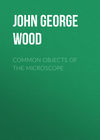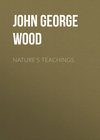Buch lesen: «Story of the Bible Animals», Seite 37

THE BEE
The Honey Bee of Palestine—Abundance of Bees in the Holy Land—Habitations of the wild Bee—The honey of Scripture—Domesticated Bees and their hives—Stores of wild honey—The story of Jonathan—The Crusaders and the honey.
Fortunately, there is no doubt about the rendering of the Hebrew word debôrah, which has always been acknowledged to be rightly translated as "Bee."
The Honey Bee is exceedingly plentiful in Palestine, and in some parts of the country multiplying to such an extent that the precipitous ravines in which it takes up its residence are almost impassable by human beings, so jealous are the Bees of their domains. Although the Bee is not exactly the same species as that of our own country, being the Banded Bee (Apis fasciata), and not the Apis mellifica, the two insects very much resemble each other in shape, colour, and habits. Both of them share the instinctive dislike of strangers and jealousy of intrusion, and the Banded Bee of Palestine has as great an objection to intrusion as its congener in this country.
Several allusions are made in the Scriptures to this trait in the character of the Bee. See, for example, Deut. i. 44: "And the Amorites, which dwelt in that mountain, came out against you, and chased you, as bees do, and destroyed you in Seir, even unto Hormah." All those who have had the misfortune to offend Bees will recognise the truth of this metaphor, the Amorites swarming out of the mountain like wild Bees out of the rocky clefts which serve them as hives, and chasing the intruder fairly out of their domains.

THE BEE
A similar metaphor is employed in the Psalms: "They compassed me about; yea, they compassed me about; but in the name of the Lord I will destroy them.
"They compassed me about like bees, they are quick as the fire of thorns, but in the name of the Lord I will destroy them."
The custom of swarming is mentioned in one of the earlier books of Scripture. The reader will remember that, after Samson had killed the lion which met him on the way, he left the carcase alone. The various carnivorous beasts and birds at once discover such a banquet, and in a very short time the body of a dead animal is reduced to a hollow skeleton, partially or entirely covered with skin, the rays of the sun drying and hardening the skin until it is like horn.
In exceptionally hot weather, the same result occurs even in this country. Some years before this account was written there was a very hot and dry summer, and a great mortality took place among the sheep. So many indeed died that at last their owners merely flayed them, and left their bodies to perish. One of the dead sheep had been thrown into a rather thick copse, and had fallen in a spot where it was sheltered from the wind, and yet exposed to the fierce heat of the summer's sun. The consequence was that in a few days it was reduced to a mere shell. The heat hardened and dried the external layer of flesh so that not even the carnivorous beetles could penetrate it, while the whole of the interior dissolved into a semi-putrescent state, and was rapidly devoured by myriads of blue-bottles and other larvæ.
It was so thoroughly dried that scarcely any evil odour clung to it, and as soon as I came across it the story of Samson received a simple elucidation. In the hotter Eastern lands, the whole process would have been more rapid and more complete, and the skeleton of the lion, with the hard and horny skin strained over it, would afford exactly the habitation of which a wandering swarm of Bees would take advantage. At the present day swarms of wild Bees often make their habitations within the desiccated bodies of dead camels that have perished on the way.
As to the expression "hissing" for the Bee, the reader must bear in mind that a sharp, short hiss is the ordinary call in Palestine, when one person desires to attract the attention of another. A similar sound, which may perhaps be expressed by the letters tst, prevails on the Continent at the present day. Signor Pierotti remarks that the inhabitants of Palestine are even now accustomed to summon Bees by a sort of hissing sound.
Whether the honey spoken of in the Scriptures was obtained from wild or domesticated Bees is not very certain, but, as the manners of the East are much the same now as they were three thousand years ago, it is probable that Bees were kept then as they are now. The hives are not in the least like ours, but are cylindrical vases of coarse earthenware, laid horizontally, much like the bark hives employed in many parts of Southern Africa.
In some places the hives are actually built into the walls of the houses, the closed end of the cylinder projecting into the interior, while an entrance is made for the Bees in the other end, so that the insects have no business in the house. When the inhabitants wish to take the honey, they resort to the operation which is technically termed "driving" by bee-masters.
They gently tap the end within the house, and continue the tapping until the Bees, annoyed by the sound, have left the hive. They then take out the circular door that closes the end of the hive, remove as much comb as they want, carefully put back those portions which contain grubs and bee-bread, and replace the door, when the Bees soon return and fill up the gaps in the combs. As to the wasteful, cruel, and foolish custom of "burning" the Bees, the Orientals never think of practising it.
In many places the culture of Bees is carried out to a very great extent, numbers of the earthenware cylinders being piled on one another, and a quantity of mud thrown over them in order to defend them from the rays of the sun, which would soon melt the wax of the combs.
In consequence of the geographical characteristics of the Holy Land, which supplies not only convenient receptacles for the Bees in the rocks, but abundance of thyme and similar plants, vast stores of bee-comb are to be found in the cliffs, and form no small part of the wealth of the people.
The abundance of wild honey is shown by the memorable events recorded in 1 Sam. xiv. Saul had prohibited all the people from eating until the evening. Jonathan, who had not heard the prohibition, was faint and weary, and, seeing honey dripping on the ground from the abundance and weight of the comb, he took it up on the end of his staff, and ate sufficient to restore his strength.
Thus, if we refer again to the history of John the Baptist and his food, we shall find that he was in no danger of starving for want of nourishment, the Bees breeding abundantly in the desert places he frequented, and affording him a plentiful supply of the very material which was needed to correct the deficiencies of the dried locusts which he used instead of bread.
The expression "a land flowing with milk and honey" has become proverbial as a metaphor expressive of plenty. Those to whom the words were spoken understood it as something more than a metaphor. In the work to which reference has already been made Signor Pierotti writes as follows:—"Let us now see how far the land could be said to flow with milk and honey during the latter part of its history and at the present day.
"We find that honey was abundant in the time of the Crusades, for the English, who followed Edward I. to Palestine, died in great numbers from the excessive heat, and from eating too much fruit and honey.
"At the present day, after traversing the country in every direction, I am able to affirm that in the south-east and north-east, where the ancient customs of the patriarchs are most fully preserved, and the effects of civilization have been felt least, milk and honey may still be said to flow, as they form a portion of every meal, and may even be more abundant than water, which fails occasionally in the heat of summer.... I have often eaten of the comb, which I found very good and of delicious fragrance."
The Bee represented in the illustration is the common Bee of Palestine, Apis fasciata. The lowest figure in the corner, with a long body and shut wings, is the queen. The central figure represents the drone, conspicuous by means of his large eyes, that almost join each other at the top of the head, and for his thicker and stouter body, while the third figure represents the worker Bee. Near them is shown the entrance to one of the natural hives which are so plentiful in the Holy Land, and are made in the "clefts of the rocks." A number of Bees are shown issuing from the hole.

THE HORNET AND ITS NEST.
THE HORNET
The Tzirah or Hornet of Scripture—Travellers driven away by Hornets—The Hornet used as a metaphor—Oriental symbolism—Sting of the Hornet.
Still keeping to the hymenopterous insects, we come to the Hornet. There are three passages in which occurs the word tzirah, which has been translated as Hornet. In every case when the word is mentioned the insect is employed in a metaphorical sense. See, for example, Exod. xxiii. 27, 28: "I will send my fear before thee, and will destroy all the people to whom thou shalt come; and I will make all thine enemies turn their backs unto thee.
"And I will send hornets before thee, which shall drive out the Hivite, the Canaanite, and the Hittite, from before thee."
The Hornet affords a most appropriate image for such a promise as was made to the Israelites, and was one which they must have thoroughly comprehended. The Hornets of Palestine and the neighbouring countries are far more common than our own Hornets here, and they evidently infested some parts to such an extent that they gave their name to those spots. Thus the word Zoreah, which is mentioned in Josh. xv. 33, signifies the "place of Hornets."
They make their nests in various ways; some species placing them underground, and others disposing them as shown in the illustration, and merely sheltering them from the elements by a paper cover. Such nests as these would easily be disturbed by the animals which accompanied the Israelites on their journeys, even if the people were careful to avoid them. In such a case, the irritated insects rush out at the intruders; and so great is the terror of their stings, that men and beasts fly promiscuously in every direction, each only anxious to escape from the winged foes.
The recollection of such scenes would necessarily dwell in the memory of those who had taken part in them, and cause the metaphor to impress itself strongly upon them.
It is needless to say that the passages in question might be literal statements of facts, and that the various nations were actually driven out of their countries by Hornets. Let the insects be brought upon the land in sufficient numbers, and neither man nor beast could stay in it. It is not likely, however, that such a series of miracles, far exceeding the insect-plagues of Egypt, would have been worked without frequent references to them in the subsequent books of the Scriptures; and, moreover, the quick, short, and headlong flight of the attack of Hornets is a very different thing from the emigration which is mentioned in the Scriptures, and the long journeys which such a proceeding involved.

ANTS ON THE MARCH.
THE ANT
The Ant of Scripture—Habit of laying up stores of food—The Ants of Palestine, and their habits—The Agricultural or Mound-making Ant—Preparing ground, sowing, tending, reaping, and storing the crop—Different habits of Ants—The winged Ants.
One of the best-known and most frequently quoted passages of Scripture is found in Proverbs, chap. vi. 6-8: "Go to the ant, thou sluggard; consider her ways, and be wise:
"Which, having no guide, overseer, or ruler,
"Provideth her meat in the summer, and gathereth her food in the harvest."
In Palestine Ants abound, and the species are tolerably numerous. Among them are found some species which do convey seeds into their subterranean home; and if their stores should be wetted by the heavy rains which sometimes prevail in that country, bring them to the outer air, as soon as the weather clears up, and dry them in the sun.
The writer of the Proverbs was therefore perfectly right when he alluded to the vegetable stores within the nest, and only spoke the truth when he wrote of the Ant that it was exceeding wise. Any one who wishes to test the truth of his words can easily do so by watching the first Ants' nest which he finds, the species of the Ant not being of much consequence. The nests of the Wood-Ant are perhaps the best suited for investigation, partly because the insect and its habitation are comparatively large, and, secondly, because so much of the work is done above-ground.
The most wonderful Ant in the world is one which hitherto is only known in some parts of America. Its scientific name is Atta malefaciens, and it has been called by various popular names, such as the Mound-making Ant and the Agricultural Ant on account of its habits, and the Stinging Ant on account of the pungency of its venom. This characteristic has gained for it the scientific name of malefaciens, or villanous.
The habits of this Ant were studied in Texas by Dr. Lincecum for the space of twelve years, and the result of his investigations was communicated to the Linnæan Society by C. Darwin, Esq. It is so extraordinary an account that it must be given the narrator's own words:—
"The species which I have named 'Agricultural' is a large brownish ant. It dwells in what may be termed paved cities, and, like a thrifty, diligent, provident farmer, makes suitable and timely arrangements for the changing seasons. It is, in short, endowed with skill, ingenuity, and untiring patience sufficient to enable it successfully to contend with the varying exigencies which it may have to encounter in the life-conflict.
"When it has selected a situation for its habitation, if on ordinary dry ground, it bores a hole, around which it raises the surface three and sometimes six inches, forming a low circular mound having a very gentle inclination from the centre to the outer border, which on an average is three or four feet from the entrance. But if the location is chosen on low, flat, wet land liable to inundation, though the ground may be perfectly dry at the time the ant sets to work, it nevertheless elevates the mound, in the form of a pretty sharp cone, to the height of fifteen to twenty inches or more, and makes the entrance near the summit. Around the mound in either case the ant clears the ground of all obstructions, levels and smooths the surface to the distance of three or four feet from the gate of the city, giving the space the appearance of a handsome pavement, as it really is.
"Within this paved area not a blade of any green thing is allowed to grow, except a single species of grain-bearing grass. Having planted this crop in a circle around, and two or three feet from, the centre of the mound, the insect tends and cultivates it with constant care, cutting away all other grasses and weeds that may spring up amongst it and all around outside of the farm-circle to the extent of one or two feet more.
"The cultivated grass grows luxuriantly, and produces a heavy crop of small, white, flinty seeds, which under the microscope very closely resemble ordinary rice. When ripe, it is carefully harvested, and carried by the workers, chaff and all, into the granary cells, where it is divested of the chaff and packed away. The chaff is taken out and thrown beyond the limits of the paved area.
"During protracted wet weather, it sometimes happens that the provision stores become damp, and are liable to sprout and spoil. In this case, on the first fine day the ants bring out the damp and damaged grain, and expose it to the sun till it is dry, when they carry it back and pack away all the sound seeds, leaving those that had sprouted to waste.
"In a peach-orchard not far from my house is a considerable elevation, on which is an extensive bed of rock. In the sand-beds overlying portions of this rock are fine cities of the Agricultural ants, evidently very ancient. My observations on their manners and customs have been limited to the last twelve years, during which time the enclosure surrounding the orchard has prevented the approach of cattle to the ant-farms. The cities which are outside of the enclosure as well as those protected in it are, at the proper season, invariably planted with the ant-rice. The crop may accordingly always be seen springing up within the circle about the 1st of November every year.
"Of late years, however, since the number of farms and cattle has greatly increased, and the latter are eating off the grass much closer than formerly, thus preventing the ripening of the seeds, I notice that the Agricultural ant is placing its cities along the turn-rows in the fields, walks in gardens, inside about the gates, &c., where they can cultivate their farms without molestation from the cattle.
"There can be no doubt of the fact, that the particular species of grain-bearing grass mentioned above is intentionally planted. In farmer-like manner the ground upon which it stands is carefully divested of all other grasses and weeds during the time it is growing. When it is ripe the grain is taken care of, the dry stubble cut away and carried off, the paved area being left unencumbered until the ensuing autumn, when the same 'ant-rice' reappears within the same circle, and receives the same agricultural attention as was bestowed upon the previous crop; and so on year after year, as I know to be the case, in all situations where the ants' settlements are protected from graminivorous animals."
In a second letter, Dr. Lincecum, in reply to an inquiry from Mr. Darwin, whether he supposed that the Ants plant seeds for the ensuing crop, says, "I have not the slightest doubt of it. And my conclusions have not been arrived at from hasty or careless observation, nor from seeing the ants do something that looked a little like it, and then guessing at the results. I have at all seasons watched the same ant-cities during the last twelve years, and I know that what I stated in my former letter is true. I visited the same cities yesterday, and found the crop of ant-rice growing finely, and exhibiting also the signs of high cultivation, and not a blade of any other kind of grass or weed was to be seen within twelve inches of the circular row of ant-rice."
The economical habits of this wonderful insect far surpass anything that Solomon has written of the Ant, and it is not too much to say that if any of the Scriptural writers had ventured to speak of an Ant that not only laid up stores of grain, but actually prepared the soil for the crop, planted the seed, kept the ground free from weeds, and finally reaped the harvest, the statement would have been utterly disbelieved, and the credibility not only of that particular writer but of the rest of Scripture severely endangered.
As may be inferred from the above description, the habits of Ants vary greatly according to their species and the climate in which they live. All, however, are wonderful creatures; and whether we look at their varied architecture, their mode of procuring food, the system of slave-catching adopted by some, the "milking" of aphides practised by others, their astonishing mode of communicating thought to each other, and their perfect system of discipline, we feel how true were the words of the royal naturalist, that the Ants are "little upon earth, but are exceeding wise."

ANT OF PALESTINE.
There is one point of their economy in which all known species agree. Only those which are destined to become perfectly developed males and females attain the winged state. Before they assume the transitional or pupal condition, each spins around itself a slight but tough silken cocoon, in which it lies secure during the time which is consumed in developing its full perfection of form.
When it is ready to emerge, the labourer Ants aid in freeing it from the cocoon, and in a short time it is ready to fly. Millions of these winged ants rise into the air, seeking their mates, and, as they are not strong on the wing, and are liable to be tossed about by every gust of wind, vast numbers of them perish. Whole armies of them fall into the water and are drowned or devoured by fish, while the insectivorous birds hold great festival on so abundant a supply of food. As soon as they are mated they bend their wings forward, snap them off, and pass the rest of their lives on the ground.
In consequence of the destruction that takes place among the winged Ants, the Arabs have a proverb which is applied to those who are over-ambitious: "If God purposes the destruction of an ant, He permits wings to grow upon her."















